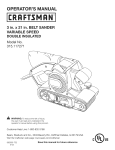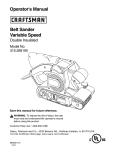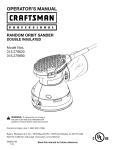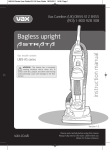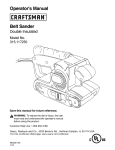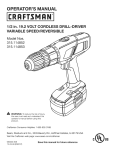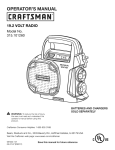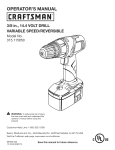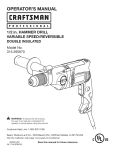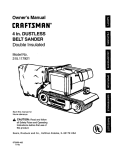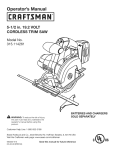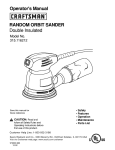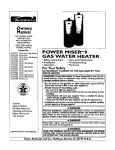Download Craftsman 315.268192 Operator`s manual
Transcript
PERATOR'S MANUAL CRRFrSMRN ° 4 in. × 24 in. BELT SANDER VARIABLE SPEED DOUBLE iNSULATED Model No. 315.268192 A WARNING: To reduce the risk of injury, the user must read and understand the operator's manual before using this product. Customer Help Line: 1-800-932-3188 Sears, Roebuck and Co., 3333 Beverly Rd., Hoffman Visit the Craftsman web page: www.sears.com/craftsman 987000-065 7-26-07 (REV:01) Save this manual Estates, IL 60179 USA for future reference [] Warranty .......................................................................................................................................................................... 2 [] Introduction ..................................................................................................................................................................... 2 [] General Safety Rules .................................................................................................................................................... 3-4 [] Specific Safety Rules ....................................................................................................................................................... 4 [] Symbols ........................................................................................................................................................................ 5-6 [] Electrical .......................................................................................................................................................................... 7 [] Features ........................................................................................................................................................................ 8-9 [] Assembly ......................................................................................................................................................................... 9 [] Operation .................................................................................................................................................................. 10-15 [] Maintenance .................................................................................................................................................................. 15 [] Exploded View and Parts List ................................................................................................................................... [] Parts Ordering/Service ..................................................................................................................................... ONE-YEAR FULL WARRANTY ON CRAFTSMAN PROFESSIONAL 1 6-17 Back Page TOOL If this Craftsman Professional tool fails to give complete satisfaction within one year from date of purchase, RETURN IT TO ANY SEARS STORE OR PARTS AND REPAIR CENTER OR OTHER CRAFTSMAN OUTLET IN THE UNITED STATES FOR FREE REPAIR (or replacement if repair proves impossible). This warranty gives you specific legal rights, and you may also have other rights which vary from state to state. Sears, Roebuck and Co., Hoffman Estates, IL 60179 This product has many features for making its use more pleasant and enjoyable. Safety, performance, have been given top priority in the design of this product making it easy to maintain and operate. and dependability A WARNING: Read and understand all instructions. Failure to follow all instructions listed below, may result in electric shock, fire and/or serious personal injury. SAVE THESE WORK INSTRUCTIONS AREA [] Keep your work area clean and well lit. Cluttered benches and dark areas invite accidents. [] Do not operate power tools in explosive atmospheres, such as in the presence of flammable liquids, gases, or dust. Power tools create sparks which may ignite the dust or fumes. [] Keep bystanders, children, and visitors away while operating a power tool. Distractions can cause you to lose control. ELECTRICAL SAFETY [] Double insulated tools are equipped with a polarized plug (one blade is wider than the other). This plug will fit in a polarized outlet only one way. if the plug does not fit fully in the outlet, reverse the plug. If it still does not fit, contact a qualified electrician to install a polarized outlet. Do not change the plug in any way. Double insulation [] eliminates the need for the three-wire grounded power cord and grounded power supply system. [] Avoid body contact with grounded surfaces such as pipes, radiators, ranges, and refrigerators. There is an increased risk of electric shock if your body is grounded. [] Don't expose power tools to rain or wet conditions. Water entering a power tool will increase the risk of electric shock. [] Do not abuse the cord. Never use the cord to carry the tools or pull the plug from an outlet. Keep cord away from heat, oil, sharp edges, or moving parts. Replace damaged cords immediately. Damaged cords increase the risk of electric shock. [] When operating a power tool outside, use an outdoor extension cord marked "W=A" or "W". These cords are rated for outdoor use and reduce the risk of electric shock. PERSONAL SAFETY [] Stay alert, watch what you are doing and use common sense when operating a power tool. Do not use tool while tired or under the influence of drugs, alcohol, or medication. A moment of inattention while operating power tools may result in serious personal injury. [] Dress properly. Do not wear loose clothing or jewelry. Contain long hair. Keep your hair, clothing, and gloves away from moving parts. Loose clothes, jewelry, or long hair can be caught in moving parts. [] Avoid accidental starting. Be sure switch is off before plugging in. Carrying tools with your finger on the switch or plugging in tools that have the switch on invites accidents. [] Remove adjusting keys or wrenches before turning the tool on. A wrench or a key that is left attached to a rotating part of the tool may result in personal injury. [] Do not overreach. Keep proper footing and balance at all times. Proper footing and balance enables better control of the tool in unexpected situations. [] Use safety equipment. Always wear eye protection. Dust mask, nonskid safety shoes, hard hat, or hearing protection must be used for appropriate conditions. [] Do not wear loose clothing or jewelry. Contain long hair. Loose clothes, jewelry, or long hair can be drawn into air vents. [] Do not use on a ladder or unstable support. Stable footing on a solid surface enables better control of the tool in unexpected situations. TOOL USE AND CARE [] Use clamps or other practical way to secure and support the workpiece to a stable platform. Holding the work by hand or against your body is unstable and may lead to loss of control. [] Do not force tool. Use the correct tool for your application. The correct tool will do the job better and safer at the rate for which it is designed. [] Do not use tool if switch does not turn it on or off. Any tool that cannot be controlled with the switch is dangerous and must be repaired. [] Disconnect the plug from power source before making any adjustments, changing accessories, or storing the tool. Such preventive safety measures reduce the risk of starting the tool accidentally. [] Store idle tools out of the reach of children and other untrained persons. Tools are dangerous in the hands of untrained users. [] Maintain tools with care. Keep cutting tools sharp and clean. Properly maintained tools with sharp cutting edges are less likely to bind and are easier to control. [] Check for misalignment or binding of moving parts, breakage of parts, and any other condition that may affect the tool's operation, if damaged, have the tool serviced before using. Many accidents are caused by poorly maintained tools. [] Use only accessories that are recommended by the manufacturer for your model. Accessories that may be suitable for one tool, may become hazardous when used on another tool. [] Keep the tool and its handle dry, clean and free from oil and grease. Always use a clean cloth when cleaning. Never use brake fluids, gasoline, petroleumbased products, or any strong solvents to clean your tool. Following this rule will reduce the risk of loss of control and deterioration of the enclosure plastic. SERVICE [] Tool service must be performed only by qualified repair personnel. Service or maintenance performed by unqualified personnel may result in a risk of injury. [] Hold tool by insulated gripping surfaces when performing an operation where the cutting tool may contact hidden wiring or its own cord. Contact with a "live" wire will make exposed metal parts of the cutting tool "live" and shock the operator. [] Know your power tool. Read operator's manual carefully. Learn its applications and limitations, as well as the specific potential hazards related to this tool. Following this rule will reduce the risk of electric shock, fire, or serious injury. [] Always wear safety glasses. Everyday eyeglasses have only impact-resistant lenses; they are NOT safety glasses. Following this rule will reduce the risk of serious personal injury. [] Protect your lungs. Wear a face or dust mask if the operation is dusty. Following this rule will reduce the risk of serious personal injury. [] Protect your hearing. Wear hearing protection during extended periods of operation. Following this rule will reduce the risk of serious personal injury. [] Inspect tool cords periodically and, if damaged, have repaired at your nearest Sears or other qualified service center. Constantly stay aware of cord location. Following this rule will reduce the risk of electric shock or fire. [] Check damaged parts. Before further use of the tool, a guard or other part that is damaged should be carefully checked to determine that it will A [] When servicing a tool, use only identical replacement parts. Follow instructions in the Maintenance section of this manual. Use of unauthorized parts or failure to follow Maintenance Instructions may create a risk of shock or injury. operate properly and perform its intended function. Check for alignment of moving parts, binding of moving parts, breakage of parts, mounting, and any other conditions that may affect its operation. A guard or other part that is damaged should be properly repaired or replaced by an authorized service center. Following this rule will reduce the risk of shock, fire, or serious injury. [] Make sure your extension cord is in good condition. When using an extension cord, be sure to use one heavy enough to carry the current your product will draw. A wire gauge size (A.W.G.) of at least 14 is recommended for an extension cord 50 feet or less in length. A cord exceeding 100 feet is not recommended, if in doubt, use the next heavier gauge. The smaller the gauge number, the heavier the cord. An undersized cord will cause a drop in line voltage resulting in loss of power and overheating. [] inspect for and remove all nails from lumber before using this tool. Following this rule will reduce the risk of serious personal injury. [] If the power supply cord is damaged, it must be replaced only by the manufacturer or by an authorized service center to avoid risk. [] Save these instructions. Refer to them frequently and use them to instruct others who may use this tool. If you loan someone this tool, loan them these instructions also. WARNING: Some dust created by power sanding, sawing, grinding, drilling, and other construction activities contains chemicals known to cause cancer, birth defects or other reproductive harm. Some examples of these chemicals are: • lead from lead-based paints, crystalline silica from bricks and cement and other masonry products, and arsenic and chromium from chemically-treated lumber. Your risk from these exposures varies, depending on how often you do this type of work. To reduce your exposure to these chemicals: work in a well ventilated area, and work with approved safety equipment, such as those dust masks that are specially designed to filter out microscopic particles. Someof the followingsymbolsmaybe usedon this product.Pleasestudythemandlearntheirmeaning.Proper interpretation ofthesesymbolswill allowyouto operatetheproductbetterandsafer. SYMBOL NAME DESIGNATION/EXPLANATION V Volts Voltage A Am pe res Current Hz Hertz Frequency (cycles per second) W Watt Power Minutes Time Alternating Current Type of current Direct Current Type or a characteristic no No Load Speed Rotational speed, at no load [] Class II Construction Double-insulated .../min Per Minute Revolutions, strokes, surface speed, orbits etc., per minute @ Wet Conditions Alert Do not expose to rain or use in damp locations. Read The Operator's Manual To reduce the risk of injury, user must read and understand operator's manual before using this product. Eye Protection Always wear safety goggles or safety glasses with side shields and, as necessary, a full face shield when operating this product. Safety Alert Precautions that involve your safety. No Hands Symbol Failure to keep your hands away from the blade will result in serious personal injury. No Hands Symbol Failure to keep your hands away from the blade will result in serious personal injury. No Hands Symbol Failure to keep your hands away from the blade will result in serious personal injury. No Hands Symbol Failure to keep your hands away from the blade will result in serious personal injury. Hot Surface To reduce the risk of injury or damage, avoid contact with any hot surface. min 0 ,A @ @ @ ® of current construction Thefollowingsignalwordsandmeanings areintendedto explainthe levelsofriskassociated withthisproduct. SYMBOL SIGNAL MEANING DANGER: Indicates an imminently hazardous situation, which, if not avoided, will result in death or serious injury. WARNING: Indicates a potentially hazardous situation, which, if not avoided, could result in death or serious injury. CAUTION: Indicates a potentially hazardous result in minor or moderate injury. situation, which, if not avoided, may CAUTION: (Without Safety Alert Symbol) Indicates a situation that may result in property damage. SERVICE Servicing requires extreme care and knowledge and should be performed only by a qualified service technician. For service we suggest you return the product to your nearest SEARS PARTS AND REPAIR SERVICE CENTER for repair. When servicing, use only identical replacement parts. ,_ A WARNING: To avoid serious personal injury, do not attempt to use this product until you read thoroughly and understand completely the operator's manual. If you do not understand the warnings and instructions in the operator's manual, do not use this product. Call the Craftsman Consumer Helpline at 1-800-932-3188 for assistance. WARNING" The operation of any power tool can result in foreign objects being thrown into your eyes, which can result in severe eye damage. Before beginning power tool operation, always wear safety goggles or safety glasses with side shields and, when needed, a full face shield. We recommend Wide Vision Safety Mask for use over eyeglasses or standard safety glasses with side shields. Always use eye protection which is marked to comply with ANSI Z87.1. SAVE THESE INSTRUCTIONS DOUBLE INSULATION Double insulation is a concept in safety in electric power tools, which eliminates the need for the usual three-wire grounded power cord. All exposed metal parts are isolated from the internal metal motor components with protecting insulation. Double insulated tools do not need to be grounded. _, WARNING: The double insulated system is intended to protect the user from shock resulting from a break in the tool's internal insulation. Observe all normal safety precautions to avoid electrical shock. NOTE: Servicing of a product with double insulation requires extreme care and knowledge of the system and should be performed only by a qualified service technician. For service, we suggest you return the product to your nearest Sears or other qualified service center for repair. Always use original factory replacement parts when servicing. ELECTRICAL CONNECTION This tool has a precision-built electric motor. It should be connected to a power supply that is 120 volts, 60 Hz, AC only (normal household current). Do not operate this tool on direct current (DC). A substantial voltage drop will cause a loss of power and the motor will overheat. If your tool does not operate when plugged into an outlet, double-check the power supply. EXTENSION CORDS When using a power tool at a considerable distance from a power source, be sure to use an extension cord that has the capacity to handle the current the tool will draw. An undersized cord will cause a drop in line voltage, resulting in overheating and loss of power. Use the chart to determine the minimum wire size required in an extension cord. Only round jacketed cords listed by Underwriter's Laboratories (UL) should be used. When working outdoors with a tool, use an extension cord that is designed for outside use. This type of cord is designated with "WA" on the cord's jacket. Before using any extension cord, inspect it for loose or exposed wires and cut or worn insulation. **Ampere rating (on tool faceplate) 0-2.0 2.1-3.4 3.5-5.0 5.1-7.0 7.1-12.0 12.1-16.0 Cord Length Wire Size (A.W.G.) 25' 16 16 16 16 14 14 50' 16 16 16 14 14 12 100' 16 16 14 12 10 -- **Used on 12 gauge - 20 amp circuit NOTE: AWG = American Wire Gauge A A WARNING: Keep the extension cord clear of the working area. Position the cord so that it will not get caught on lumber, tools or other obstructions while you are working with a power tool. Failure to do so can result in serious personal injury. WARNING: Check extension cords before each use. If damaged replace immediately. Never use tool with a damaged cord since touching the damaged area could cause electrical shock resulting in serious injury. PRODUCTSPECIFICATIONS BeltSize.......................................................... 4 in. × 24 Sanding Surface .................................................. in. 25 sq. in. Input ................................. 120V, 60 Hz, AC only, 11 Amps Net Weight ................................................................ 14 Ibs. No Load Speed ............................. 800-1,300 r/rain. (RPM) DUST BAG FRONT HANDLE TRACKING KNOB REAR HANDLE SANDING BELT TENSION RELEASELEVER VARIABLESPEED ADJUSTMENTDiAL VACUUM ADAPTOR LOCK-ON BUTTON SWITCH TRIGGER DUST EXHAUST Fig. 1 KNOWYOURBELTSANDER TENSION See Figure 1. The tension release lever aids in quick and easy belt changes. The safe use of this product requires an understanding of the information on the product and in this operator's manual as well as a knowledge of the project you are attempting. Before use of this product, familiarize yourself with all operating features and safety rules. TRACKING RELEASE LEVER KNOB The tracking knob allows you to easily adjust the belt tracking. DUST BAG VACUUM The dust bag attaches to the sander and keeps dust to a minimum. The vacuum adaptor allows you to connect to a 1-1/4 in. or 2-1/2 in. diameter vacuum hose to help keep the work area clean. ERGONOMIC DESIGN The design of the sander provides for easy handling. It is designed for comfort and ease of operation in different positions and at different angles. LOCK-ON ADAPTOR VARIABLE SPEED ADJUSTMENT DIAL The variable speed adjustment dial allows you to adjust speeds from 800-1,300 surface feet per minute for different types of materials and applications. BUTTON The lock-on feature allows you to lock the switch trigger in the ON position. Locking the switch trigger on allows you to operate the sander for extended periods of time. UNPACKING ,_ This product has been shipped completely assembled. [] Carefully remove the product and any accessories from the box. Make sure that all items listed in the packing list are included. WARNING: If any parts are damaged or missing do not operate this product until the parts are replaced. Failure to heed this warning could result in serious personal injury. A [] Inspect the product carefully to make sure no breakage or damage occurred during shipping. WARNING: Do not attempt to modify this product or create accessories not recommended for use with [] Do not discard the packing material until you have carefully inspected and satisfactorily operated the product. this product. Any such alteration or modification is misuse and could result in a hazardous condition leading to possible serious personal injury. [] If any parts are damaged or missing, please call 1-800-932-3188 for assistance. PACKING LIST Belt Sander Sanding Belt Dust Bag Vacuum Adaptor Operator's Manual A WARNING: Do not connect to power supply until assembly is complete. Failure to comply could result in accidental starting and possible serious injury. ,_ TENSIONRELEASE LEVER WARNING: Do not allow familiarity with products to make you careless. Remember that a careless fraction of a second is sufficient to inflict serious injury. A A WARNING: Always wear safety goggles or safety glasses with side shields when operating power tools. Failure to do so could result in objects being thrown into your eyes resulting in possible serious injury. WARNING: Do not use any attachments or accessories not recommended by the manufacturer of this product. The use of attachments or accessories not recommended can result in serious personal injury. Fig. 2 APPLiCATiONS [] Install the sanding belt. You may use this product for the purposes listed below: [] Sanding wood, metals, plastics, and other materials CAUTION: [] Smoothing rough boards, chamfering, rounding edges, etc. belt, ensure that the arrow inside the belt is pointing in the direction of the rotation (clockwise when looking into the open side of the sander). Installing unidirectional sanding belts backwards can create a hazardous condition. [] Removing rust, paint, varnishes, and stains SELECTING SANDING BELTS Selecting the correct size and type of sanding belt is an important step in achieving a high quality sanded finish. Aluminum oxide, silicon carbide, and other synthetic abrasives are best for power sanding. If the sanding belt is not a bidirectional [] Align the sanding belt to its correct position. [] Lower the tension release lever to secure the sanding belt. Coarse grit removes the most material and fine grit produces the best finish. The condition of the surface to be sanded determines which grit will do the best job. If the surface is rough, start with a coarse grit and sand until the surface is uniform. Then use medium grit to remove scratches left by the coarser grit. Finally, use finer grit for finishing the surface. Always continue sanding with each grit until the surface is uniform. INSTALLING/CHANGING SANDING BELTS See Figures 2 - 4. [] Unplug the sander. [] Position the sander on its side with the cord on the left. A WARNING: Keep hands and fingers clear of the rollers and spring mechanism at all times. Failure to do so could result in fingers getting pinched, causing serious injury. J TENSIONRELEASELEVER (IN RELEASEDPOSITION) [] Raise the tension release lever. NOTE: If you are changing sanding belts, remove the old sanding belt at this time. 10 Fig. 3 iNSTALLUNiDiRECTiONALBELTSiN THE DiRECTiONOFTHE ROTATION iNSTALLBiDiRECTiONALBELTSiN EITHERDiRECTiON Fig. 4 Fig. 5 CAUTION: If the sanding belt wears excessively on the inner edge, it is probably adjusted too far inward and is rubbing against internal parts. If this is the case, readjust the tracking knob. WARNING: Before connecting the sander to a power supply, always make sure it is not in the "locked-on" position. Failure to do so could result in accidental starting of the sander resulting in possible serious injury. ADJUSTING SANDING [] Start the sander and fine adjust the tracking knob until the belt stabilizes. BELT TRACKING A See Figures 5 - 6, Belt life sanding edge of edge of is greatly increased if you regularly adjust the belt tracking. When correctly adjusted, the outer the sanding belt should be even with the outer the base of the sander. When you install a new sanding belt, you may need to adjust the sanding belt tracking several times until the belt becomes pliable. WARNING: Keep hands and fingers away from a moving sanding belt. Any part of the body coming in contact with a moving sanding belt could result in serious injury. Do not wear loose clothing or jewelry when operating the sander. They could get caught in moving parts, and foreign objects could get thrown away from the sander, causing injury. TURN COUNTERCLOCKWISE IF BELTBUNS OUTWARD [] Connect the sander to a power supply. [] Position the sander upside down with the cord on the left. NOTE: This position is for adjustments only. The sanding belt should not contact a workpiece or any foreign object when you are making belt tracking adjustments. [] Depress the switch trigger and release immediately. [] Choose one of these options: [] Sanding belt runs inward: Turn the tracking knob slowly clockwise. [] Sanding belt runs outward: Turn the tracking knob slowly counterclockwise. NOTE: Turn the tracking knob until you are sure the sanding belt is secure, i.e., it will not come off the sander or contact internal parts. TURN CLOCKWISEIF BELTBUNS INWARD 11 Fig. 6 EMPTYING DUST BAG THE DUST BAG For more efficient operation, empty the dust bag when it is no more than half full. This action permits the air to flow through the bag better. Always empty and clean the dust bag thoroughly upon completion of a sanding operation and before placing the sander in storage. _IL THE DUST BAG [] Unplug the sander. The dust bag provides a dust collection system for the sander. A [] Remove the dust bag from the sander. [] Unzip the dust bag. [] Shake out the dust. WARNING: Do not use the dust bag when sanding metal. Using the dust bag when sanding metal creates a fire hazard, which could damage the tool and lead to serious personal injury. ATTACHING THE DUST See Figure 7. Collected sanding dust from sanding surface coatings such as polyurethanes, linseed oil, etc., can self-ignite in the sander dust bag or elsewhere and cause fire. To reduce the risk of fire always empty the dust bag frequently (10-15 minutes) while sanding and never store or leave a sander without totally emptying its dust bag. Also follow the recommendations of the coatings manufacturers. Fig. 7 USING WARNING: [] Zip up the dust bag. [] Replace the dust bag. NOTE: Periodically, you should turn the dust bag inside-out and thoroughly clean it. BAG [] Unplug the sander. [] Slide the dust bag retainer over the dust exhaust on the sander. 12 VACUUM ADAPTOR ,_ WARNING: When sander is not connected to vacuum, always install dust bag back on sander. Failure to do so could cause sanding dust or foreign objects to be thrown into the face or eyes which could result in possible serious injury. NOTCH NOTE: A standard 1-1/4 in. vacuum hose fits inside the smaller diameter hole inside the dust exhaust, while a standard 2-1/2 in. vacuum hose connection fits inside the larger hole of the dust exhaust. LOCK=ONBUTTON 1-I/4in. VACUUMHOSE SWITCHTRIGGER Fig. 9 SWITCH 2-1/2 in. VACUUM HOSE TRIGGER See Figure 9. [] To turn on the sander: Depress the switch trigger. [] To turn off the sander: Release the switch trigger. LOCK=ON BUTTON See Figure 9. The lock-on feature allows you to lock the switch trigger in the ON position. Locking the switch trigger on allows you to operate the sander for extended periods of time. Fig. 8 ATTACHING THE VACUUM ADAPTOR If you have the lock-on button engaged during use and the sander is accidentally disconnected from the power supply, disengage the lock-on feature immediately. Also, do not lock the switch trigger if you might need to suddenly stop the sander. See Figure 8. To attach the vacuum adaptor: [] Unplug the sander. [] Remove the dust bag from sander. [] Depress the switch trigger. [] Align notch inside vacuum adaptor with raised rib under dust exhaust. [] Push in the lock-on button. [] Slide the vacuum adaptor over the dust exhaust until adaptor clicks into place. [] Release the switch trigger. [] Release the lock-on button. NOTE: The adaptor can be positioned with the dust exhaust facing up, down, or away from the sander. NOTE: To release the lock, depress the switch trigger. 13 PROPERHANDPLACEMENT [] Move the sander slowly over the work surface, using the rear handle to control the sander and the front handle to guide the sander. See Figure 10. For ease of operation and maintaining proper control, the sander has a front handle and a rear handle. These NOTE: Allowing the sander to remain in one place will result in an uneven surface. handles allow two-handed operation, which aids in maintaining control, keeping the sanding area level with the workpiece, and keeping hands clear of the sanding belt. When operating the sander, always hold the front handle with your left hand and the rear handle with your right hand. ,_fL WARNING: The sander is designed to provide the proper weight on the sanding belt. If the sanding belt slips or does not track while sanding, you may be applying too much pressure. Excessive pressure will result in uneven work, clogged sanding belts, premature sanding belt wear, possible motor burnout, and irregular sanding belt tracking Keep hands and fingers clear of moving sanding belt, front idler roller, and drive roller assembly. Failure to do so will result in serious personal injury. A When this occurs, remove the sander from the workpiece. If you properly adjust the belt tracking, the sanding belt will return to its normal and correct position on the drive roller and front roller. WARNING: Do not let your fingers rest over the front or right edge of the sander. If the sanding belt were to run off, or if it were not properly adjusted, your fingers could come in contact with the moving sanding belt resulting in possible serious injury. Use a coarser sanding belt for heavy sanding, not heavy pressure. The weight of the tool is sufficient to provide adequate pressure at the correct location. The front roller of the sander is not designed for contour sanding. Sanding on the front roller could cause irregularity in the sanding belt tracking. Fig. 10 OPERATING THE SANDER See Figure 11. Fig. 11 [] Secure the work to prevent it from moving under the sander. ,_k WARNING: Unsecured work could be thrown towards the operator causing injury. [] Turn the sander on and let the motor reach its maximum speed before placing the sander on the work surface. [] Lower the sander to the work surface with a slight forward motion. A WARNING: Keep a firm grip on the sander with both hands at all times. Failure to do so could result in loss of control leading to possible serious injury. 14 SETTING THE BELT SANDER SPEED The sander has a variable speed control dial, A to F, designed to allow operator control of belt speed. To increase belt speed, turn the variable speed control dial to a higher setting. Turn to a lower setting to decrease belt speed. Refer to the chart below for proper speed selections. MATERIAL SPEED A B C BELT GRIT D UNDRESSED TIMBER SOFTWOOD 40 "_ "_ O ._ RUST REMOVAL 80 ._ NON FERROUS METAL 100 150 240 ._ _ ._ ._ PAINTED SURFACE _ ._ ._ ._ _ O Electric tools used on fiberglass material, wallboard, spackling compounds, or plaster are subject to accelerated wear and possible premature failure because the fiberglass chips and grindings are highly abrasive to bearings, brushes, commutators, etc. Consequently, we do not recommended using this tool for extended work on these types of materials. However, if you do work with any of these materials, it is extremely important to clean the tool using compressed air. WARNING: When servicing, use only identical Craftsman replacement parts. Use of any other parts may create a hazard or cause product damage. WARNING: Always wear safety goggles or safety glasses with side shields during power tool operation or when blowing dust. If operation is dusty, also wear a dust mask. GENERAL 60 _ ._ VENEER TIMBER A F ._ CHIPBOARD A E LUBRICATION MAINTENANCE Avoid using solvents when cleaning plastic parts. Most plastics are susceptible to damage from various types of commercial solvents and may be damaged by their use. Use clean cloths to remove dirt, dust, oil, grease, etc. All of the bearings in this tool are lubricated with a sufficient amount of high grade lubricant for the life of the unit under normal operating conditions. Therefore, no further lubrication is required. _l_lL WARNING: Only the parts shown on the parts list are intended to be repaired or replaced by the customer. All other parts should be replaced at a Sears Service Center. Do not at any time let brake fluids, gasoline, petroleum-based products, penetrating oils, etc., come in contact with plastic parts. Chemicals can damage, weaken or destroy plastic which may result in serious personal injury. 15 CRAFTSMAN BELT SANDER- MODEL NUMBER 315.268192 SEENOTE 8 7 6 15 NOTE: The assembly shown represents an important part of the double insulated system. To avoid the possibility of alteration or damage to the system, service should be performed by your nearest Sears repair center. Contact your nearest Sears retail store for service center information. 16 ._ _, CRAFTSMAN BELT SANDER - MODEL NUMBER 315.268192 % i J The model number will be foundregarding on a plate attached to the motor housing. Always mention number in all correspondence your BELT SANDER or when ordering repair parts. the model SEE BACK PAGE FOR PARTS ORDERING | INSTRUCTIONS PARTS LIST Key No. 1 Pa_ No. Description 940051014 Logo Plate ............................................................................................................. 1 Qty. Sanding Belt .......................................................................................................... 1 3 940045031 Data Plate .............................................................................................................. 1 4 300027071 5 301041001 Dust Bag ................................................................................................................ Wear Plate ............................................................................................................. 1 1 6 660327002 Screw (8-32 x 1/2 in. Pan. Hd.) **STD510805 ....................................................... 5 7 590546001 Belt Cover .............................................................................................................. 1 8 511973001 Belt ........................................................................................................................ 1 _ 9 660106002 Lock Nut ................................................................................................................ 1 10 680335009 Washer (4.0 x 10.0 x .08) ....................................................................................... 1 11 680335011 Washer (6.3 x 18.3 x 0.5) ....................................................................................... 1 12 680335010 Washer (5.0 x 13.0 x 1.0) ....................................................................................... 1 13 690725001 Compression Spring .............................................................................................. 1 14 300898002 Tracking Knob Assembly ....................................................................................... 1 15 591624001 Vacuum Adaptor .................................................................................................... 1 987000065 Operator's Manual (not shown) * Standard Hardware Item = May Be Purchased Locally ** Available From [:)iv. 98 = Source 980.0 *** Complete assortment available at your Nearest 17 Sears Retail Store

















